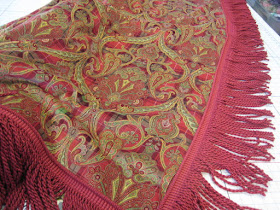Waiting for Sandy.......
I spent Sunday afternoon prepping the studio in case it takes on water when Sandy storms in. After a flash flood some 5 or 6 years ago, everything went into bins, onto shelves, or under the tables on pallets; but for a hurricane, that's not reassuring enough. We put all fabrics up onto the work tables, along with the compressor, shop vac, and other electrical stuff. I vacuumed thoroughly because it is just gross to have to clean up after a flood when the floor was full of lint, threads, string, fabric bits, you name it. Ask me how I know.
On the gridded table are some of my to-go bags. I prepped a bunch of shades and draperies to take home for sewing by hand. My work computer came home with me, and an assortment of sewing supplies. At least I can get some work done even without electricity. I'm assuming it'll be at least Wednesday before we have power and the roads get cleared.
Yeah, some 5 or 6 summers ago I was working, alone in the building, on a super-hot July afternoon. A severe storm blew across the Hudson and let loose. Suddenly I heard a loud "crack" and the sound of the water seemed ominously different. I ran to the back hallway door to see what was going on. I was afraid the back wall had collapsed, but instead a wall of water was rushing from the office at the other end, past the closets and rest rooms, straight for me. I say "wall" of water because that's what it felt like to me, but of course it was just a few inches deep. It was, however, very wet, and rushing madly towards everything I owned, so I freaked out, slammed the door shut (silly, because the water just came underneath!), and in sheer panic started grabbing everything I could reach, throwing things haphazardly up onto the work table any old way. What a mess. I got everything that was electrical out of the water, and luckily I got to the fabrics or materials that belonged to customers before the water did. Next I ran for the computer and other electronics, propping them up on the desk, chairs, whatever I could find. A big stash- I mean a BIG STASH- of hoarded leftover fabrics were left to fend for themselves, and got themselves wet. A lot of other stuff got wet, too. By the time I was done, the water had reached most of my room, and my heartrate was about 190. I can't believe I didn't have a heart attack.
It was a freak storm, a flash flood, and the normally more than adequate drainage was not up to the volume. The management company immediately called in a crew to improve the drainage system and we haven't had a problem since, but when I was able to get back into the building to clean up, I bought tons of plastic bins and now everything that touches the floor is in a bin or on higher pallets. However, the memory of that flood makes me very uneasy when the words "hurricane" or "nor'easter" start appearing in the weather forecast!






.jpg)




.jpg)






























.JPG)







